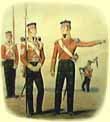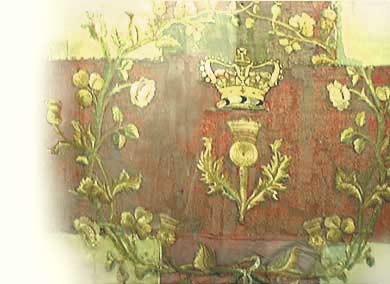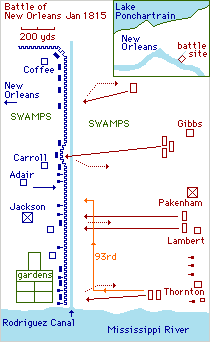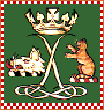Scottish History
The history of the Argyll and Sutherland Highlanders
The Regimental Museum in Stirling Castle
The Battle of New Orleans, 1815

For this expedition the 93rd were deprived of their kilts and feathered bonnets and sent into action in tartan trews and a particularly unbecoming form of cocked Kilmarnock bonnet. But they were well led, and their morale was by now indestructible, though, as Private Neil McIntosh wrote home afterwards, "General Mismanagement" commanded throughout. The admirals, whose greed for prize-money is said to have prompted the whole expedition, were callous and incompetent. The Commander-in-Chief, Sir Edward Pakenham and his three brigade commanders were indecisive. None of the staff knew his job.

Detail of the Kings Colour carried at the Battle of New Orleans
The 93rd landed on the evening of 23 December, having spent six days and nights packed in open boats exposed to rain, sleet and a bitter north wind. They moved up through the swamp where the advance guard was surprised by a night attack by 1,200 militiamen. By dawn the Americans withdrew, leaving behind 74 prisoners.
General Andrew Jackson (later to be President of the U.S.A.) made his stand behind the Rodriguez Canal 5 miles from New Orleans. Across his mile-long front he built, out of cotton bales and sugar casks filled with earth, a parapet twenty feet deep with a short glacis sloping down to the canal bank; and on it he mounted four well-protected heavy guns. Along the parapet, invisible and almost invulnerable, he had about 3,500 men.

On 28 December Pakenham drew up 750 yards in front of this position. On the 8th January after 2 unsuccessful advances he ordered the third. Everything went wrong. There was not enough earth to build gun batteries, only a quarter of the force could get across the canal.
On the right Lieutenant-Colonel Moleyns lost his head and led the 44th in a panic flight which spread to the rest of Major-General Samuel Gibbs's Brigade. A few gallant parties crossed the canal without ladders. Gibbs and Pakenham were killed.
On the left three light companies, among them the 93rd, stormed a redoubt on the river bank from which the whole enemy line could have been turned. But there too the Brigade Commander was killed, and the advance came to a standstill. The 93rd alone pushed out into the centre until they were only 1OO yards short of the ditch. Their Commanding Officer was killed. His successor would neither advance nor retire without a clear order. So there they stood rock-like, in close order, being slowly destroyed by the concentrated fire of the whole American line, until Lambert, the surviving General, after a careful survey, at last withdrew them. They came back with parade-ground precision, leaving three-quarters of their total strength killed or wounded and having laid the foundations of an immortal legend: a reputation for disciplined and indomitable courage. An American observer later commented; 'It was an act of cool determined bravery'. The British had nearly 2,000 casualties that day, of whom 557 were from the 93rd. The Americans behind their parapet had 6 killed and 7 wounded.
Ironically, lack of communication meant that neither side knew that peace had in fact been signed two weeks before the battle. Wounded prisoners, all of whom had been well treated in American hospitals, were returned; and the 93rd were able to muster half their original strength when they landed back in Britain.


